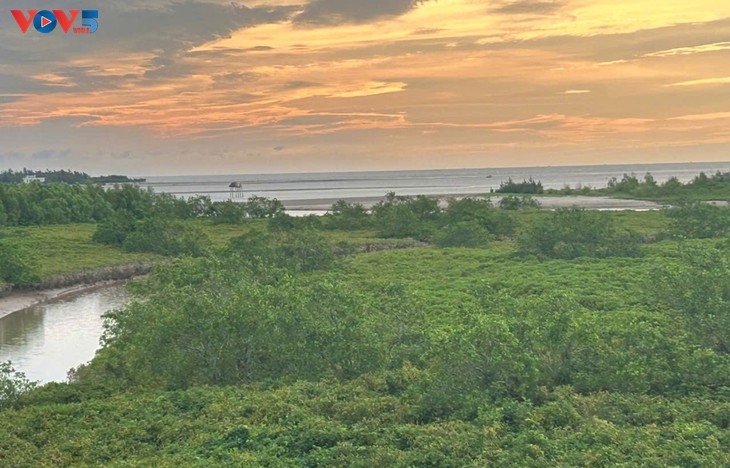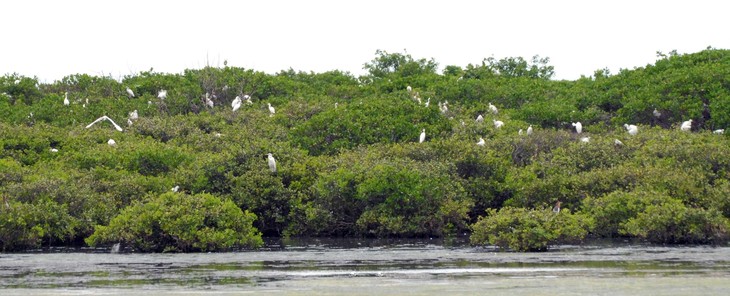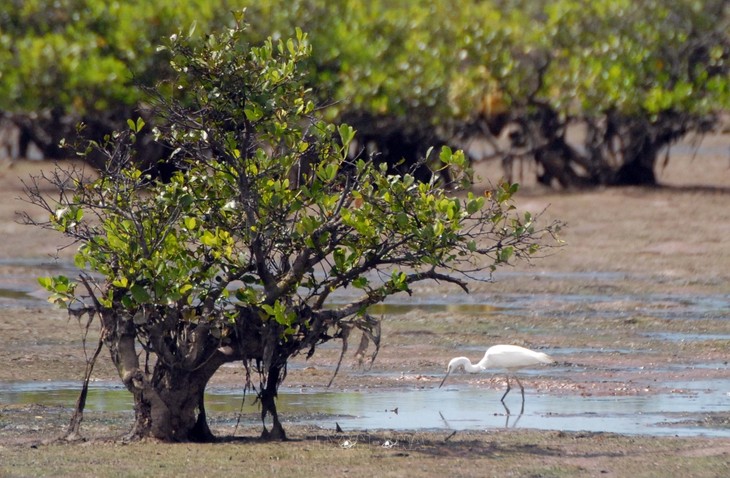Xuan Thuy National Park has a diverse ecosystem and is also a famous tourist destination in Ninh Binh province. It is the first wetland in Southeast Asia to join the Ramsar Convention and has been recognized by UNESCO as the core zone of the Red River Delta Biosphere Reserve. The Park is being nominated as an ASEAN Heritage Park.

A panoramic view of Xuan Thuy National Park in Ninh Binh province (photo: Kim Lieu/ VOV5)
Xuan Thuy National Park, Vietnam’s northern wetland area, is located at the mouth of the Red River which flows into the Gulf of Tonkin.
The Park’s core zone spans 7,100 hectares, including swamps, mudflats, tidal areas, and mangrove forests. There are lush green mangroves interspersed with scattered ponds and tidal flats. It’s home to more than 200 plant species, 110 species of plankton, 385 species of invertebrates, 155 species of fish, and 427 species of insects.
Xuan Thuy is known as an “international bird station” or “paradise for birds,” as it serves as a stopover for migratory birds flying south to escape the harsh northern winter. It shelters 222 bird species, including many rare waterbirds listed in the International Union for Conservation of Nature Red List of Threatened Species such as the spoon-billed sandpiper, Asian dowitcher, and black-faced spoonbill. The Park is home to the largest number of spoonbills in Vietnam.
With its vast mangrove ecosystem and wild natural scenery, the community-based ecotourism is seen as a suitable model for sustainable development here.

Xuan Thuy serves as a stopover for migratory birds flying south to escape the harsh northern winter. (photo: Quang Quyet/ VNA)
Vu Quoc Dat, Deputy Director of Xuan Thuy National Park, said: “Xuan Thuy National Park, located in the estuarine area of the Red River in northern Vietnam, is known for its typical wetland ecosystem representing both estuarine and coastal environments. In recent years, with growing public interest in nature, the number of visitors has been on the rise. Tourists can travel through mangrove forests of the Red River and Ba Lat estuary and experience activities like catching fiddler crabs, wading through mudflats to harvest clams, or joining mangrove planting programs.”
On average, Xuan Thuy welcomes 20,000 to 25,000 visitors annually. During holidays, it can receive up to 4,500 visitors. Activities such as watching migratory birds, taking river cruises, sightseeing in the countryside, experiencing coastal fishermen’s life, or exploring mangrove forests bring fascinating and memorable experiences for visitors.

White storks in Xuan Thuy National Park (photo: Quang Quyet/ VNA)
These tours are carefully planned and customized to suit different groups of visitors, from little children to students and researchers.
Elementary school pupils from Hanoi said: “I saw storks, birds, and cranes. They are so big! I got to see all the birds I like. I am very happy.”
“This trip is fun. I learned about many bird species and visited lots of places.”
British tourist Felix Jones said: “This is the first time I have visited a national reserve in Vietnam. I am very impressed by the natural beauty and vastness of this place. The wetland is stunning with its thriving wildlife. I enjoy coming here.”
Student Trinh Thi Khanh Linh from the Hanoi National University said: “This is a beautiful place with rich, biodiverse mangrove forests and coastal landscapes. I think this is a very attractive tourist destination. We can take a boat trip to venture further into the park to explore the mangrove forests and diverse species of plants and animals.”
The outstanding feature of ecotourism at Xuan Thuy National Park is the combination of tourism and environmental protection. Visitors can explore the ecosystem and gain insight into studies of migratory birds, aquatic life, and forest restoration processes.
Kim Lieu